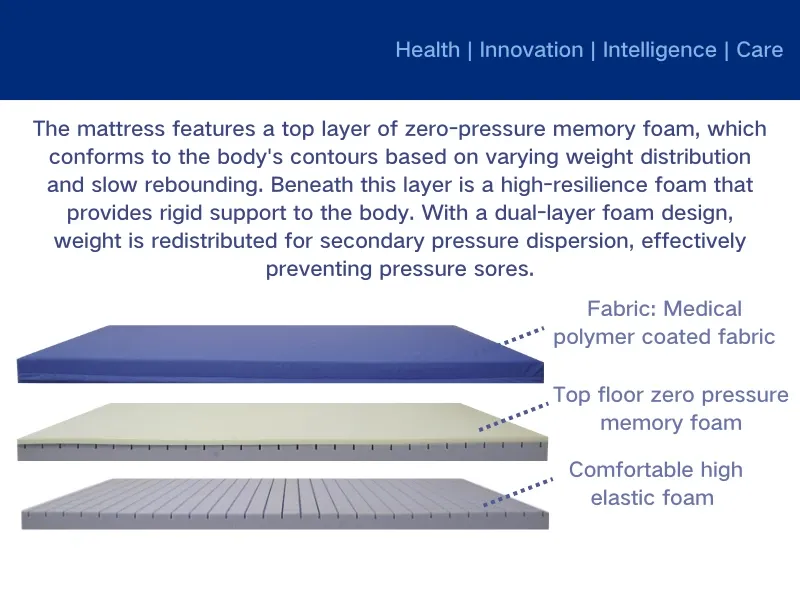The Role of ICU Nursing Silicon Mattress in Preventing Pressure Ulcers
In intensive care units worldwide, pressure ulcers remain a significant challenge affecting patient outcomes and healthcare costs. The emergence of specialized silicone mattress technology has revolutionized preventive care for immobilized patients. Unlike conventional hospital bedding, these advanced silicone gel mattress systems are engineered to actively redistribute pressure and minimize shear forces - two primary contributors to tissue breakdown. For critically ill patients confined to mattress for adjustable hospital bed systems, the integration of silicone-based support surfaces represents a major advancement in both therapeutic comfort and clinical outcomes.

The Science Behind Silicone Mattress Technology
Modern silicone bed mattress designs incorporate sophisticated material science to address the complex pathophysiology of pressure ulcer development. These medical-grade surfaces utilize viscoelastic silicone polymers that demonstrate unique properties:
Adaptive contouring that responds to patient anatomy
Dynamic pressure redistribution capabilities
Temperature-regulating characteristics
Shear force reduction through surface tension management
The silicone gel mattress variant takes these benefits further by incorporating gel-infused matrices that provide additional microclimate control. This combination of mechanical support and physiological maintenance creates an optimal environment for preserving skin integrity in high-risk ICU patients.
Silicone Mattress: Pressure Redistribution Mechanisms
The primary silicone mattress function in ulcer prevention lies in its unparalleled pressure distribution capabilities. When compared to standard comfortable hospital bed mattress options, silicone-based systems demonstrate:
40-60% greater pressure dispersion across contact surfaces
Continuous adaptation to patient movement
Reduced peak pressures at bony prominences
Even weight distribution regardless of patient position
These characteristics prove particularly valuable when integrated with mattress for adjustable hospital bed systems, where frequent position changes might otherwise create new pressure points. The material's memory properties ensure consistent protection even as bed configurations change to meet clinical needs.
Silicone Mattress: Microclimate Management Features
Beyond mechanical pressure relief, silicone gel mattress products excel in maintaining optimal skin microenvironments:
Moisture vapor transmission prevents maceration
Breathable surfaces reduce heat accumulation
Hygienic non-porous structure inhibits bacterial growth
Thermal neutral properties prevent excessive warming
This comprehensive microclimate control addresses multiple secondary factors contributing to pressure ulcer formation, making the silicone bed mattress a multifunctional therapeutic surface rather than simply a comfortable support.
Clinical Outcomes with Silicone Mattress Implementation
Healthcare facilities adopting ICU-grade silicone mattress systems report measurable improvements in several key metrics:
50-70% reduction in hospital-acquired pressure injuries
Decreased wound care resource utilization
Improved patient comfort scores
Reduced repositioning frequency requirements
Lower incidence of moisture-associated skin damage
The integration of these surfaces with modern mattress for adjustable hospital bed systems has proven particularly effective for high-risk patient populations, including those with limited mobility, vascular compromise, or nutritional deficiencies that impair tissue resilience.
Silicone Mattress: Comparative Advantages Over Traditional Surfaces
When evaluated against conventional comfortable hospital bed mattress options, silicone-based systems demonstrate clear clinical superiority:
Long-term Performance: Maintain therapeutic properties beyond typical mattress lifespans
Hygiene Maintenance: Non-absorbent surfaces allow thorough disinfection
Patient Compliance: Improved comfort increases tolerance for prolonged bed rest
Staff Efficiency: Reduced need for manual repositioning eases nursing workload
Cost-Effectiveness: Lower overall treatment costs despite higher initial investment
These advantages position the silicone gel mattress as both a clinical and operational improvement for modern ICUs.
Silicone Mattress: Implementation Considerations for Critical Care Units
Successful deployment of silicone bed mattress systems requires careful planning:
Patient Assessment Protocols: Identifying appropriate candidates for silicone surfaces
Staff Training: Proper use of advanced features in mattress for adjustable hospital bed configurations
Cleaning Procedures: Maintaining infection control with specialized materials
Outcome Monitoring: Tracking pressure ulcer incidence and severity metrics
Healthcare facilities must view these surfaces as active therapeutic devices rather than passive comfort items to fully realize their ulcer prevention potential.
Silicone Mattress: Transforming ICU Patient Care
The integration of advanced silicone bed mattress systems into critical care represents a paradigm shift in pressure ulcer prevention. By combining scientific material engineering with clinical ergonomics, these surfaces address the multifactorial nature of tissue breakdown more effectively than traditional comfortable hospital bed mattress options. As part of complete mattress for adjustable hospital bed systems, silicone technology empowers healthcare teams to provide safer, more therapeutic care for vulnerable ICU patients. The demonstrated reductions in pressure ulcer incidence confirm these surfaces as essential components of modern preventive care protocols, ultimately improving patient outcomes while optimizing healthcare resource utilization.
-
The Science Behind Silicon Mattresses for Critical Care EnvironmentsAktualnościJul.16,2025
-
The Role of Wave Mattress Systems in Pressure Ulcer PreventionAktualnościJul.16,2025
-
Long-Term Bedridden Patients and the Advantages of Silicon Mattresses in the ICUAktualnościJul.16,2025
-
From ICU to Home Care: Expanding the Use of Silicon Mattresses for Nursing NeedsAktualnościJul.16,2025
-
Choosing the Right Wave Mattress for Different Levels of Patient CareAktualnościJul.16,2025
-
The Effect of Coconut Foam Mattress Breathability and Humidity Regulation on Improving Sleep QualityAktualnościJul.03,2025
-
How Wave Mattress Systems Improve Blood Circulation During ImmobilityAktualnościJul.03,2025

